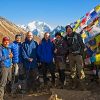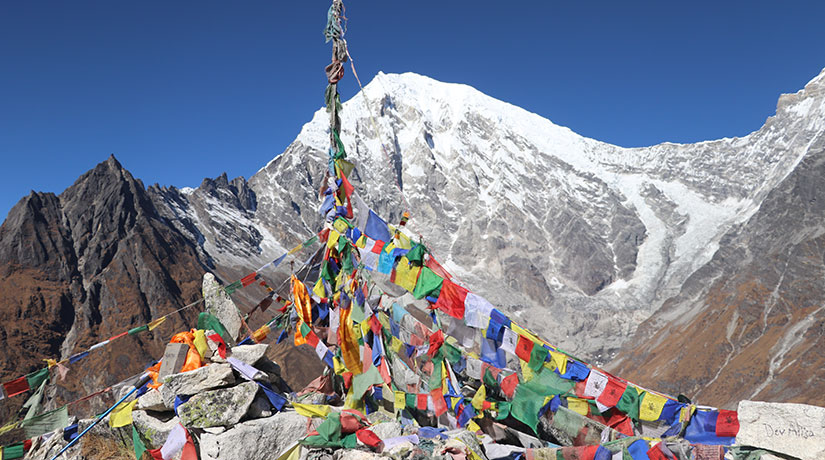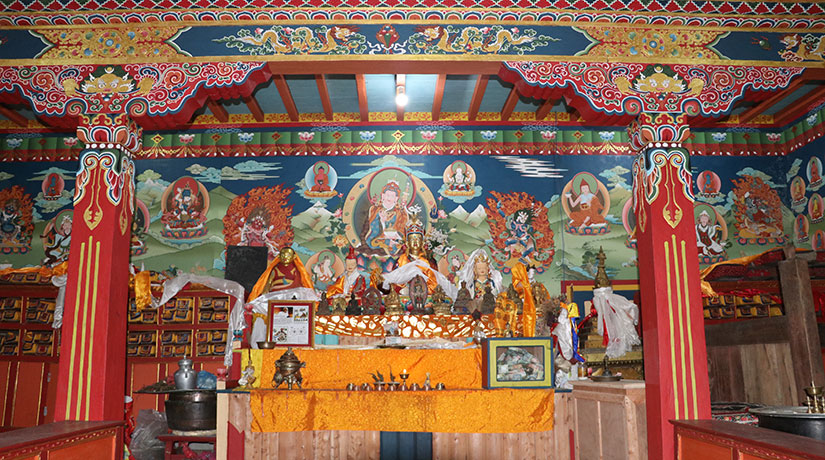Trip Facts
General trp informationsMin. 2 PAX
4984m Tsergo-Ri
Full Board
Private Vehicles/Public Bus
Nestled in the lap of Langtang Himal, a Beyul visited and blessed by Padma Sambhava. One of the most popular trekking destination; Nepal best trekkers call this a paradise on earth.
Beyul Namgo-dagam is a Beyul among the 5 most important Beyuls in Nepal Himalayas, which means hidden treasure land shaped like ‘Heavenly Gate of Half-Moon Form’. This Beyul lies in the Langtang (gLang ’phrang) valley in Rasuwa district of Nepal.
This Beyul is revealed by Rigzin Gö-demchen (1337-1408), the famous Terton (gter ston, ‘treasure finder’) of teachings hidden throughout the Himalaya by the Buddhist saint Padma Sambhava, is reputed to be the most influential figure contributing to the popularity of the Beyul idea. The concept of Beyul had aroused much interest amongst Tibetans, especially the adherents of the Nyingmapa and inspired many an adventure and legend. This Beyul at a later stage, made it accessible to practitioners by Guru Tseten Gyaltsen. The ritual opening of Namgo-dagam is associated with the following foundation story, which lent the valley its name Langtang.
Now for the origin of what is called Lantang (gLang-’phrang) an Ox is said to have been killed once in Bridim (’Bri-bstim) during the consecration feast for the erection of a Stūpa of gold and silver by one patron. That evening miraculously the Ox fled to that hidden valley by reason of his supernatural knowledge. The valley was discovered by virtue of the fact that the owner followed its trail; for this reason the valley is known under the name Ox Passage—so it is said in the tales of the people of old.
Another similar legend suggests that once there was a marriage ceremony to be held in Kyirong Tibet. In those days, during the ceremony they were to sacrifice one ox (glang) and one female yak (’bri), and they were discussing how to manage and kill them. The animals overheard it and so they made a plan to escape. They escaped, and a shepherd followed behind them. There is a place near Timure where they rested for a while. After that they came here and the female yak vanished into the soil. So it is called Bridim. The Tibetan spelling of Bridim provides important clues to the origin of the village’s name: ’bri is a female yak, bstim is dissolved or absorbed into.
The Ox fled from Bridim to towards hidden valley through Khanjim village. (Kha - means mouth and Khanjim is bellowing mouth). There is a place called Langtasa where the ox was believed to be tied. Even today there is a small rock with holes, which seems very similar to Ox nostrils. There are several places with the legends like Lang Rilkyo where Ox was dropped now it’s called Rimoche, After crossing the current Lama Hotel the Ox was disappeared so it’s called Langtor gang (Langtor – Ox missing and Gang- Hill), when the Ox was grazing in a bush the follower took rest so this place got its name Thangshyab. Before getting in Langtang the ox stretches its legs so the place got its name Kangtangsa (In Tibetan - leg stretching), when Ox got in the valley he got very good grasses so he grazed well and reposed contently so it called Langtang (Lang – Ox, Tang – happily reposed), the ox further moved and got in a place where he stretched his head and body so it got its name Kyangjen (Go – Head, Kyangkyo – stretching body with head)
One site named Langshisa (Glang shi sa), “Spot where the Ox was dead”, probably refers to the same story; to this day, local people there perform a commemoration rite for the Ox in every 2 years turn by turn with Guru Rinpoche Cave (Tarna phug) in Langtang base camp on the full moon day of August-September/Bhadra in Nepal.
Tibetan origin people have settled in this hidden valley. Pilgrims here come to meditate at Kyanzin Monastery and in some of the nearby caves. The most important cave is the one associated with Padma Sambhava, located at a two hours’ walk from the Kyanjin Gompa, near the eastern base camp of Langtang Lirung.
Local belief insists on abandoning any corpse on a clearing, without cremation; claiming that doing so leads to that person’s liberation.
Four routes have been used in the past to reach the main entry point of this hidden land; only two of these are still in use at present:
- From Syabrubesi to Kyangzin Gompa, an approach from the southwest, this is the easiest and common route all trekkers and local inhabitants use it. It starts from the Langtang Khola.
- From Genjala pass (5,130m.) to Kyangzin Gompa, approaching the valley from the east. Most peak climbers use it through Ama Yangri and Pema Chal (Padma Tshal).
- From Melamchighyang to Kyangzin Gompa, one used to reach the valley from the south. This way is now blocked, the result of a massive landslide, long ago, and
- From Tibet to Kyangzin Gompa, then entering the valley from the north. This access route was rendered impracticable by the Nepal army during the Nepal-Tibet war (1788-1792) but from Tilman Pass (5,308m) northeast is another route to get in the hidden valley.
Langtang region is not only important spiritually; this Langtang trek is un-spoilt with its high peaks and deep valleys, pristine environment, awe-inspiring mountains, lakes, its enchanting natural scenery, and the remoteness of its valleys, also well-spring of countless legends, myths and romantic imaginings, engendering the sacralisation of the landscape that had served as a source of religious inspiration for peoples living both its vicinity and beyond.
The Langtang valley itself encompasses several ecological zones, from relatively fertile subtropical forests at the western entrance of the valley, to the rocky, wind-swept stretches of Himalayan pasture that support herds of bovines belonging mainly to the valley’s inhabitants.
Starting at the western entrance of Syabrubesi on the edge of the Langtang National Park, you climb through beautiful thick oak and rhododendron forests up to Langtang village. Home to Himalayan black bear, the goat-like Himalayan Tahr, Langoors, rhesus Monkeys, wild boars and red Pandas! At Kyanjin Gompa is last settlement and like an oasis from where you get close up views of Langtang Lirung (7,246m) and other mountains that separate Nepal from Tibet.
Backtracking for a day to the village of Lama Hotel from Kyanjin Gompa, you can come Syabrubesi through Sherpa gaun and Khanjim villages on the way back rather same trail down.
Outline Itinerary
Day 01: International arrival (1,350m /4,429ft)
Day 02: World Heritage Sightseeing in Kathmandu (1,350m /4,429ft)
Day 03: Drive to Syabrubesi (1,503m / 4,931ft) 6-7 hrs
Day 04: Trek to Lama Hotel (2,410m / 7,906ft) 6-7 hrs
Day 05: Trek to Langtang Village (3,430m /11,253ft) 5-6 hrs
Day 06: Trek to Kyanjin Gompa (3,830m / 12,565ft) and climb to Kyanjin-Ri (4,600m / 15,091ft) in the afternoon 8 hrs
Day 07: Hike to Tsergo-Ri (4,984m / 16,351ft)) 7-8 hrs
Day 08: Trek to Langshisa (4,285m / 14,058ft) and back to Kyanjin (3,830m / 12,565ft) 8-9 hrs
Day 09: Visit to Guru Rinpoche Cave in Tarna (Langtang Lirung base camp) back to Kyanjin Hotel (3,830m / 12,565ft) 4-5 hrs
Day 10: Trek to Lama Hotel (2,410m / 7,906ft) 6-7 hrs
Day 11: Trek to Syabrubesi (1,503m / 4,931ft) 5-6 hrs
Day 12: Drive back to Kathmandu 6-7 hrs
Day 13: International Departure
What's included?
- All meals (Menu Choice) during trek
- Lantang National Park Permit, and Trekkers Information Management System (TIMS) Fees.
- Accommodation in Teahouse Lodges during Trek. (Twin sharing basis or double room)
- 10 days Trek is accompanied by a well experienced English speaking Trekking guide and porters
- 1 day sightseeing in Kathmandu accompanied by tourist guide
- 12 nights accommodation in local lodges sharing twin room on full board according to itinerary. (Breakfast, Lunch, Dinner and Tea/Coffee)
- Salary, insurance, food, accommodation of Guide and Crews.
- Loan of sleeping bag, duffel bags and trekking poles.
- 03 nights hotel in Kathmandu sharing twin / double room (on Bed and Breakfast Plan)
- Airport transfers and escorts on private vehicle fares.
- Kathmandu Syabrubesi Kathmandu jeep fares.
- Trekking map and Trekking poll.
- Mobile Sim card provides (without-balance). Emergency rescue service arrangements only. Payable from your travel insurance.
- Farewell Dinner
Note: 1 porter will carry a maximum weight of 25kgs, 1 porter for every 2 guests and 1 Sherpa will accompany every 5 guests). Includes all meals, accommodation, allowance, Kathmandu/Syabrubesi/Kathmandu vehicle fare of Guide & Crews, insurance of guide and crews & crews equipment
We will provide the best available Local Lodges in Langtang region based on the room availability. Please also expect that some of the local lodges in higher elevation may not have attached bathrooms here. Hence, clients will have to adjust on common bathrooms as well. However, we will try our best to allocate the rooms with attached bathroom wherever available.
What's not included?
- International airfares.
- Nepal visa fee.
- Travel insurance / Medical evacuation and Helicopter Rescue in case of emergency (Compulsory).
- Personal trekking and Climbing Equipment (available on hire) not mentioned.
- Tips for trekking staffs and driver.
- Any items of personal nature such as telephone bills, laundry, bar bills.
- Cost of Showers during trek, Internet & Battery Charge.
- Gamow Bags, fleece liner, down jacket, rain poncho, etc.
- Extra transfers in Kathmandu except listed in inclusion.
- Any other items not mentioned in the cost inclusion.
- The prices do not include undue escalation in fuel prices, new taxes levies on hotels and transportation services or any hikes in entrance fees. Any large tax hikes and new levies shall be payable extra and shall be billed accordingly with prior notice.
- Any beverages, including Mineral water, Beers, Alcoholic and Non Alcoholic drinks, etc. unless otherwise specified.
- Meals while staying in Kathmandu.
- Extra nights in Kathmandu and extra days on the trek.
- Extra baggage charges and Extra Porters.
- Tips, any expenses incurred in emergency evacuation/roadblock due to any reason. Tented service if trekkers want one night stay in Langshisa.
Your first impression of landing at Tribhuvan International Airport of Kathmadu valley surrounded by green hills is an experience in itself. But don’t be worried, as your Bodhi Adventures representative will be waiting to welcome you with your name placard. Our representative will welcome by Marigold garland. Depending on traffic, you will be transfer at your hotel within 20 minutes.
The day is spent visiting some of the major World Heritage Sites of Kathmandu including Swayambhu or Boudhanath. You will have enough time in the afternoon to prepare for your trek and check that you have everything you need before you leave Kathmandu. If you want to visit Thamel, the tourist hub of Nepal where you can easily find all you need for trekking. There are many cafes and bakeries serving excellent local tea and coffees.
Drive to Syabrubesi (1,503m / 4,931ft)
6-7 Hrs Teahouse Lodge
The road trip start crossing the northern valley ridge and drop into Trisuli valley. The trail believed to be taken by Guru Padma Sambhava, Atisha etc. to get to Tibet. The drive up to Syabrubeshi offers some spectacular views of Ganesh Himal, Langtang Ri, Langtang Lirung, Naya Kanga, Dorje Lakpa and Manaslu with Himalchuni in the west. It can be a rough and rocky ride, but as you climb and cross by Kalikasthan, the mountains of the Langtang region become closer and bigger.
Trek to Lama Hotel (2,410m / 7,906ft)
6-7 Hrs Basic Teahouse Lodge
The trail from Syabrubesi to Lama Hotel (the name of the village) follows the Langtang Khola and is very scenic. You walk through the dense forest where you might see Langur monkeys, Red Pandas or even Himalayan black bears. After crossing a bridge over the Langtang Khola you climb a steep trail to Rimche (Rimoche) from where trail meets from Sherpa gaun and Bamboo. Rimche to Lama Hotel is about 30 minutes leveled walk.
Trek to Langtang Village (3,430m /11,253ft)
5-6 Hrs Teahouse
Continuing up from Lama Hotel you can start to enjoy the mountain landscape, accompanied by the Sound of Langtang River. As you reach the green meadows of Pering Kharka you start to see the white peaks of the Langtang range. Your National Park and TIMS permits are registered here. This place called Ghoda Tabela – once at the Rana regime period it was horse-breeding center. Your trail climbs up the widening valley and passes Thangshyap (where protected pair of Grand father and grand mother Stupa is erected) and Gompa small settlements with teahouse lodges. Crossing the big landslide area of last 2015 earthquake, you reach Langtang village. The village was completely wiped out by a massive avalanche that followed the earthquake in April 2015, now the village is almost recovered.
Trek to Kyanjin Gompa (3,830m / 12,565ft) and climb to Kyanjin-Ri (4,600m / 15,091ft) in the afternoon
8 Hrs Teahouse
Continuing up from Langtang to Mundo is gentle steep then spectacular view of Gangchhenpo seems in front. You pass by mani walls, prayer wheels, chortens, mounds of mani rocks with holy prayers scripted on them and the small hydropower recently built by Kadoori a British welfare organization, we get to Kyangjin Gompa. It’s the last settlement of the valley. And itself the Gompa of Kyanjin is a principal monastery in the region. You have time to explore the Buddhist Gompa and surrounding areas.
In the afternoon, after lunch optional climb to Lower Kyanjin-Ri first and if fit then to upper Kyanjin-Ri. This places to admire the views Langtang Lirung I (7,246m), Langtang Lirung II (6,581m) and Nayakanga (5,846m). The view of Lirung Tsang Glacier, one the biggest glaciers in the Langtang range is impressive.
Hike to Tsergo-Ri (4,984m / 16,351ft)
7-8 Hrs Teahouse
Nearby northern mountains separates Nepal from Tibet and is part of a series of high peaks including Shishapangma Mountain (8,013m / 26,289ft) and Porong Peak (7,292m). It was climbed for the first time by a Japanese expedition team in 1981 and since then is a popular climbing peak.
Tsergo-Ri is the one of the holy hill and best viewpoint for the surrounding mountains including Yala Peak (5500m), Langtang Lirung I (7,246m), Langtang Lirung II (6,581m) and Nayakanga (5,846m), Gang Chenpo (6387m), Urkinmang (6,151m) Langshisa Ri (6,427m) etc.
Religious trekkers with strong Buddhist faith are suggested to visit Langshisa about 13km away from Kyanjin but no settlement for teahouse lodges so to/from is about 26km walk but this is the place where ox was believed to be dead. We pass through Chyadang (3900m) and Numthang (3940m) to get Langshisa. Still some meditators use a rock cave in Numthang for retreat. Recently a shelter house is built in Langshisa too. In Langshisa some self-arisen marks belong to the ox are there. Local people commemoration rite for the ox every two years here.
Visit to Guru Rinpoche Cave in Tarna (Langtang Lirung base camp) back to Kyanjin Hotel (3,830m / 12,565ft)
4-5 Hrs Teahouse
The Guru Rinpoche cave is in the base of Langtang Lirung, other side of the Langtang glacier. The trail goes below the ice lake and the trail gets into pastureland of bovines. After 2 hours walk you get in the Cave. The cave can contain about 30 people; it is inside the big boulder. We meditate about half an hour here with great devotion.
Trek to Lama Hotel (2,410m / 7,906ft)
6-7 hrs Teahouse
Retracing your steps to Lama Hotel, most of the day is downhill through forests and same villages Mundu, Langtang, Thyangsyap, Ghoda Tabela etc.
Trek to Syabrubesi (1,503m / 4,931ft)
5-6 Hrs Teahouse
There are two options to get Syabrubesi. One option is same trail retracing back via bamboo. Another option is take upper trail lengthier having Langtasa where Guru Rinpiche had believed to be spent a night and tied an Ox in a rock. The rock has two holes exactly ox nostrils. Then trail further goes to Sherpa Gaon then Khanjim to descend down to Syabrubesi.
Drive back to Kathmandu
6-7 Hrs Hotel
Your private vehicle Jeep or local jeep or bus you can take back to Kathmandu as your program.
Transfer to International Airport for your home return. Wishing next Beyul Trek. We say good-bye with Khata – Good Luck Scarf!
Reviews

Peter Bonifacio
Australia
DEEPLY CARES ABOUT HIS CLIENTS, WORKERS AND ENVIRONMENT!
2019
[caption id="attachment_836" align="aligncenter" width="576"] Peter's Group from Langtang Trek 2019[/caption] Man Raj deeply cares about his clients, workers and the environment in a way that is consistent with his deeply
TIFFANY HESTING
America
I COULDN’T ASK FOR A BETTER GUIDE
2017
I spent two days with Man Raj as he showed a friend and I around Kathmandu and the surrounding area. He was so knowledgeable! He took his time explaining so




